28 November 2024
Wind-to-Wake Concept for Shipping Decarbonization
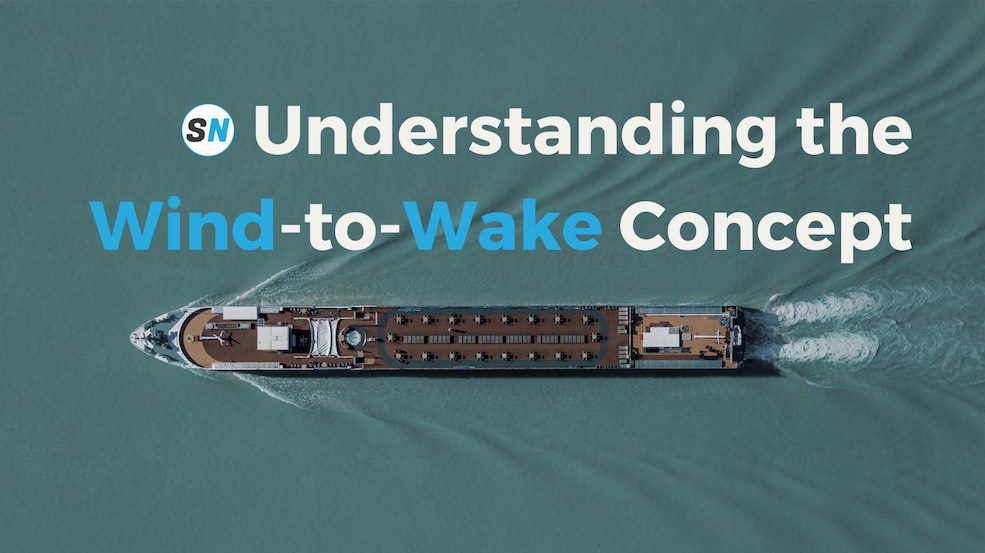
Shipping decarbonization goes beyond funnel emission goals and subsequent fuelling options. Get up to speed with Wind-to-Wake, the updated method of lifecycle assessment for green fuels.
Authors: P. Manias, S. Turnock, D. Teagle and D. Hudson
Southampton Marine & Maritime Institute, University of Southampton
Table of Contents
Summary
A lifecycle assessment (LCA) provides an objective approach for comparing future marine fuels that are produced from renewable energy while accounting for their greenhouse gas (GHG) emissions footprint at every step of their lifecycle from the point of production until the point of use. Greenhouse Gas emissions pose an existential threat to humanity through global warming and climate change. Maritime shipping is almost wholly reliant on the combustion of fossil fuels with resultant carbon dioxide equivalent emissions and significant contributions to air pollution from oxides of nitrogen, sulphur, and particulate matter combustion products.
The future route to fuelling ships is likely to be from renewable energy resources. A benchmarking process of the three main alternatives of ammonia, methanol, and hydrogen must be used, to identify the fuel that requires the least amount of renewable energy investment compared to the energy required to propel a ship through the water, at the same time as minimizing air pollution. Hydrogen is likely to be the most cost-effective solution with the unit of renewable electricity required to produce an amount of storage energy as fuel, being an effective measure for the overall cost and lowest environmental harm.
Why Decarbonize Maritime Activities?
One of the many challenges society will be facing in the coming decades is the rapid decarbonization of all human activities. Polluting greenhouse gas (GHG) emissions pose major threats to global societies and essential ecosystems. Temperature increases will have difficult to predict, detrimental and unprecedented impacts, and many regions may become uninhabitable. Increasing atmospheric CO2, leading to global warming, is not the only problem, with air pollution responsible for 4.2 million deaths every year. To put this into perspective, the COVID-19 pandemic was responsible for 6.9 million deaths over 4 years.
The rise of atmospheric greenhouse gas concentrations, which mainly include carbon dioxide (CO2), methane (CH4), and nitrous oxide (N2O), expressed as CO2equiv., is principally due to the burning of fossil fuels such as coal, oil, and natural gas since the industrial revolution with a very rapid increase from the late 20th Century.
The shipping industry contributes approximately 2% of the global CO2equiv. emissions. This proportion could be perceived as “minor” by people within the industry when considering that maritime enables 90% of the world’s trade. However, CO2 is only one component of the environmental impact, with ships contributing ~15% of global NOx and SOx emissions, and 2% of global particulate matter (PM2.5), bearing proportionate responsibility for the total number of deaths due to air pollution.
The Role of the IMO
In 2023, the International Maritime Organisation (IMO), the United Nations body responsible for overseeing shipping and maritime trade, strengthened its ambitions on GHG emissions regulations and reductions with the agreement of MEPC 80 that announced the long-term aim of reaching net zero emissions by, or around, 2050. Until MEPC 78 in 2018, the IMO aspired to only a 50% reduction by 2050. These reductions will be partially achieved through increased efficiencies but also require the disruptive pivot from unabated hydrocarbon combustion to low-carbon fuels and, where possible, electrification.
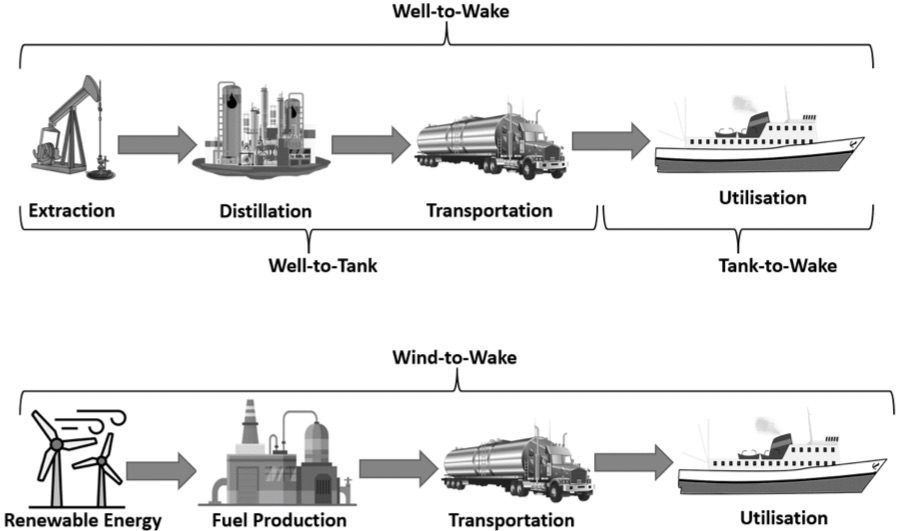
Until recently, emission evaluations of different fuels were carried out on a “Tank to Wake” basis (Figure 1), where emissions were only considered in terms of funnel output. This approach is due to change, according to MEPC 80, to a more holistic “Well-to-Wake” assessment requiring that emissions from extraction, distillation, and transportation must also be accounted for in addition to the vessel’s direct emissions. This approach can be extended towards the new generation of low-carbon fuels such as ammonia, methanol, and biofuels used in combustion engines or zero-carbon fuels like hydrogen or even nuclear.
Old Technologies in the New Era of Shipping
Although internal combustion engines have well-established reliability and dependability standards, their principle of operation has inherent efficiency losses, as well as a proportion of incomplete fuel mixture combustion. Even with major improvements in engine design, the high temperatures reached during combustion encourage the formation of NOx molecules. SOx is produced whenever sulphur is present either through oil intrusion inside the combustion chamber or most commonly from the fuel combusted, which is the case with Heavy Fuel Oil (HFO), which is one of the most common marine fuels.
Post-combustion exhaust treatments might be able to remove CO2 (Figure 2), and in conjunction with other devices, significantly reduce SOx and NOx emissions. However, the introduction of such equipment increases the complexity of a vessel’s powertrain, and overall reliability, ultimately impacts its energy efficiency, and can pose serious risks to aquatic life, if open loop.
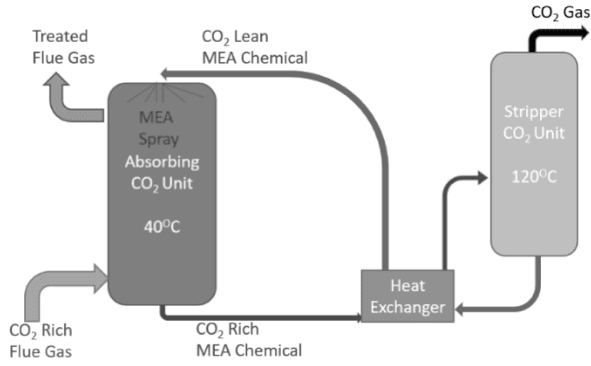
Some alternative fuels provide a solution for “Tank-to-Wake” emissions by not containing carbon or sulphur while other approaches suggest lowering combustion temperatures to reduce NOx formation. However, such approaches fail to account for the energy and emissions impacts of the rest of the fuel’s lifecycle.
A Colorful “Palette” of Fuels
All current methanol, ammonia, hydrogen, and bio-fuel production at scale share a common weakness, namely their dependence upon fossil fuels in at least one part of their lifecycle.
When it comes to production, “grey” is often used to designate how each sustainable fuel option is derived from fossil fuels when none of the resulting carbon emissions are captured, whereas “blue” indicates that a significant portion of the CO2 emissions has been captured. This part of the fuel production process is not considered in a “Tank-to-Wake” assessment, hence the push towards “Well-to-Wake”, in line with ISO standard 14044. However, it is important to note that the production process is only part of the total dependence of “sustainable” shipping fuels on carbon-intensive energy sources.
Another significant proportion of emissions comes during the utilization stage where a pilot fuel, most commonly diesel, is still required for the combustion of many low-carbon fuels. In looking towards a green future, where the fuel for ships is generated using just renewable energy resources, we will need a new mindset that considers the total route from wind-to-wake (or indeed solar) rather than well-to-wake.
Sustainability & Fossil Fuels
An Energy Return On Investment index (EROI) typically used within the fossil fuel industry, is a ratio that compares the energy required to produce an energy equivalent unit against its final energy output at the point of utilization. During the past decades, EROI indicates a steady and significant increase in energy requirement to produce every unit of energy equivalence. For example, in the 1990’s a barrel of oil was required to produce 35 barrels of oil whereas in 2006 a barrel of oil was required to produce 18 barrels of oil, the energy requirement rise being in parallel with the rising cost of fossil fuels.
The EROI index does not include the minimum amount of energy required to capture the resulting emissions or the cost for doing so, with the European Emissions Trading System being a possible path of “taxing” carbon emissions by setting a price per ton of CO2.
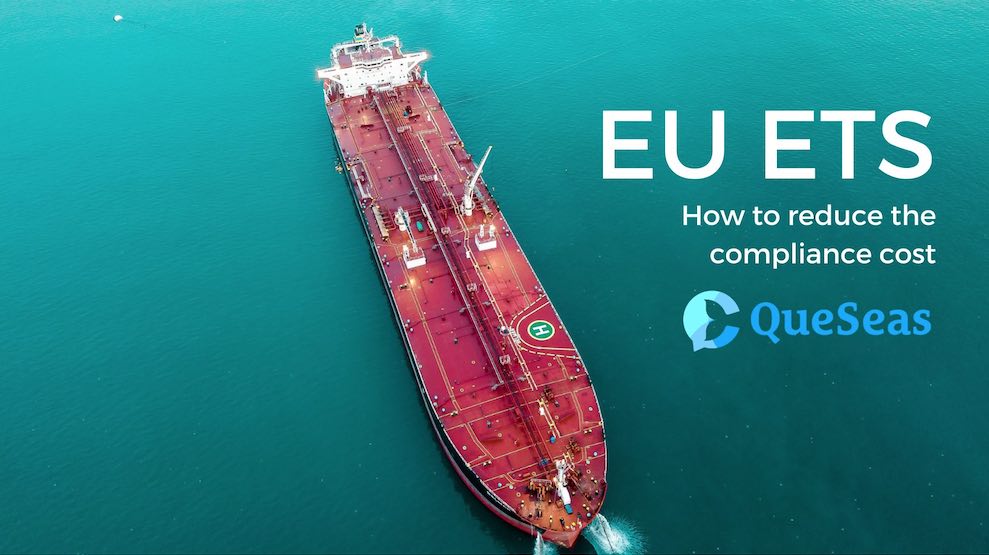
A potential loophole in the EU ETS
Queseas has published an article focusing on the side effects of the inclusion of shipping in the EU Emissions Trading System (EU ETS).
Ship Nerd
Wind-to-Wake
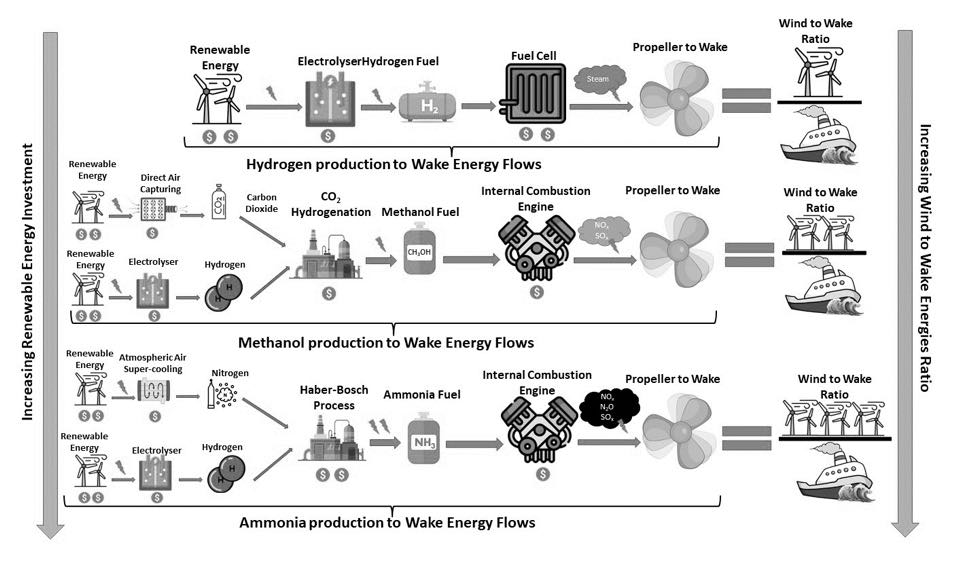
When considering the possible choices of future fuels between hydrogen, ammonia, and methanol, the choice should depend on their Wind-to-Wake energy flow (shown in Figure 3), expressed in terms of total energy input against energy output at the propeller and then the embedded carbon footprint per unit of energy produced. Considering that renewable energy resources must be used to create net-zero fuels, developing energy-efficient methods to produce these green fuels, is essential. Wind-to-Wake, (Figure 1) appears to be the energy path with the least amount of embedded carbon footprint per energy unit (7gCO2/kWhe) produced, in comparison to Sun-to-Wake (14gCO2/kWhe). However, this does not stand as a limit towards exploring less carbon-intensive renewable energy sources.
An interesting question to ask is “When will renewable energy resources be able to offer a similar or better EROI value to that of fossil fuel extraction and capturing of their resulting emissions”. In the meantime, the use of a carbon tax and measures like the CII (Carbon Intensity Index of vessel operations) of the IMO will encourage the more rapid uptake of net zero fuels by the shipping sector, by reducing the effective cost differential.

When considering the most promising future fuels, namely ammonia, methanol, and hydrogen (Table 1), it is important to appreciate that green hydrogen production is required for all of them (Figure 4).
| Fuel Type | LH2 | Methanol | LNH3 |
| ρ (kg/m3) | 71 | 780 | 653 |
| Lower Calorific Value (LCV) (MJ/kg) | 120 | 19.9 | 18.6 |
| Embedded Production Energy (per kg) | 170 MJ | 39.6 MJ | 43.2 MJ |
| Wind-to-Wake energy ratio (MJ/MJ) | 1.4 : 1 | 2.0 : 1 | 2.3 : 1 |
Liquid hydrogen is the green fuel with the least amount of manufacturing energy input compared to its exergy (Wind-to-Wake Ratio). In contrast, methanol (WtW 2.0) and ammonia (WTW 2.3) require at least twice the energy for production compared to their calorific value. These scenarios assume CO2 is captured from the atmosphere to ensure that no new CO2 is being added overall.
Part of the gain achieved with hydrogen is through the use of a fuel cell which has a higher efficiency than a combustion engine as well as only having clean emissions (steam). Since the dominant cost in generating these alternative fuels is the energy input required to manufacture them, the fuel with the lowest WtW energy ratio is likely to be the most cost-effective, green fuel, expressed as cost per unit of energy.
Take Home Message
With the modern era of net-zero shipping at its dawn, it is important to establish a new holistic assessment of sustainably produced fuels. This method of assessment must be different from the one used until now, in the same way, that a “Mine-to-Wake” concept would seem very much outdated by today’s standards.
Unlike underground oil extraction, manufactured green fuels that rely on the utilization of renewable energy sources, require careful and strategic planning to ensure sufficient and affordable renewable energy is available for everyone. This is where a Wind-to-Wake approach could be applied, with the aim of minimizing the initial energy required and more efficiently utilizing the sustainable fuel produced on board each vessel, while at the same time eliminating emissions.
Read the full article here.
See Also
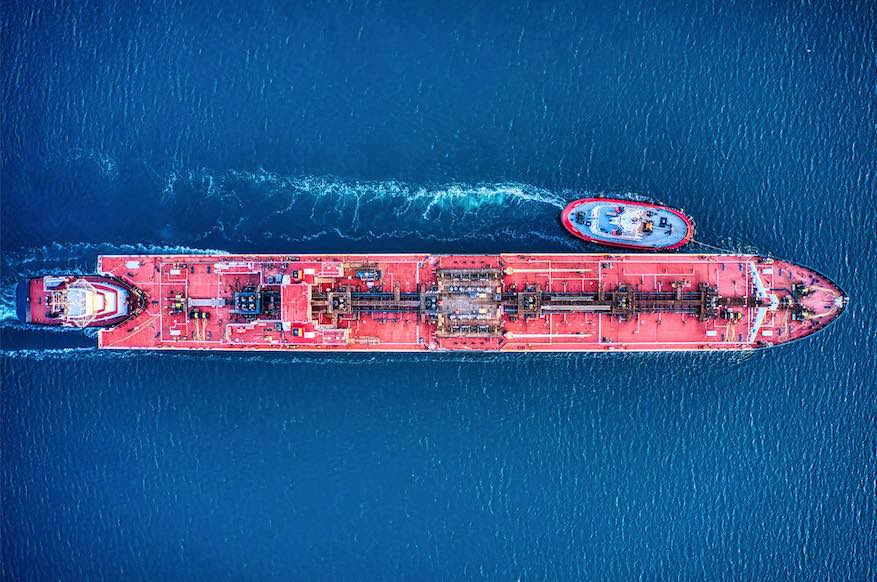
Accelerating the green energy transition before 2030
Global warming is at a record pace, breaching the 1.5°C target by mid-2030s. Accelerating the green energy transition can still turn things around.



